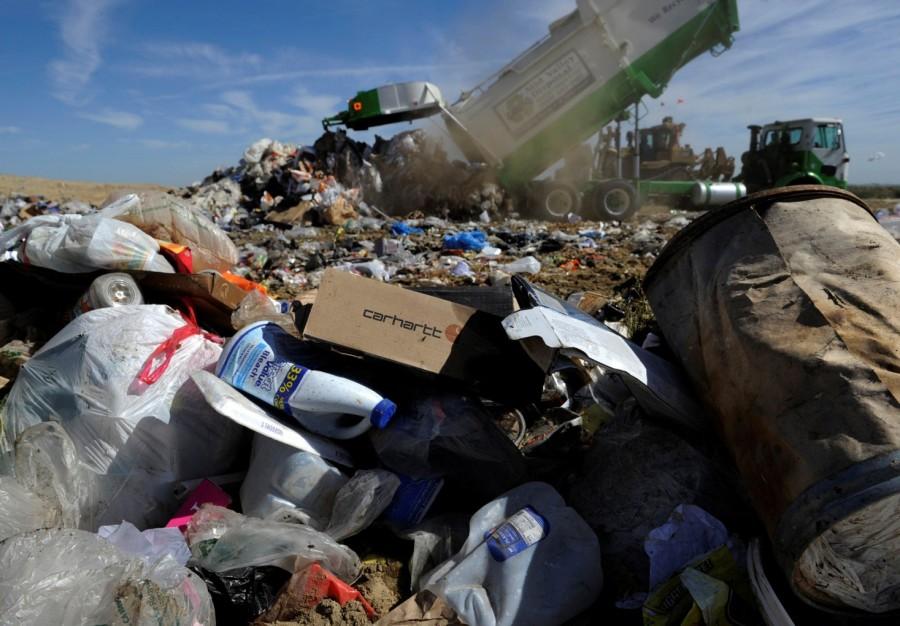Zero Waste: In Maryland, plans, but not actions, to reduce trash
October 22, 2015
Many local families, like mine, have at least two 32-gallon trash cans and a recycle bin outside. On trash day, at least one is full.
Recycling is not everyone’s top priority when it comes to problems in the world, but it should be. According to Annenburg Learner, on average in 2013 each American produced about 4.6 pounds a trash a day. More than half of the trash we produce goes to landfills.
What does a day of trash look like? Granola bar wrappers, soda cans (recyclable), cereal boxes (recyclable), leftover food scraps and broken earphones and phone chargers, plastic bags, water bottles (recyclable) and foam paper plates.
The Washington Post reported that by the year 2025 people will have doubled the amount of trash per day from 3.5 million to 6 million tons. That’s the amount of world trash created every single day. Without drastic measures in the right direction, by the year 2040, we will produce 11 million tons of trash per day.
If you saw the movie Wall-E, I think that’s what our earth WILL look like!
Former governor Martin O’Malley issued an executive order in January 2015 to drive forward a plan called The Zero Waste Plan for Maryland. The Zero Waste plan is a plan to decrease waste to 20% and increase recycling to 80% by 2040. This plan is a long-term goal to help reuse resources and prohibits new landfills from being formed.
If Maryland is so far behind (compared to other states) in waste management, how are we going to do this?
According to the Maryland Department of Environment, the citizens in Maryland generate more municipal solid waste (MSW) per person than any other single state in the United States.
Basically, that’s a nice way of saying that Marylanders are really slacking in the waste department.
In San Francisco, there is a law that states apartment buildings must have three different bins for the residents’ waste. The law states there must now be a composting bin along with recycling and trash bins.
Maryland is not the only state trying to completely eliminate waste. Hawaii, Colorado and Texas are among some of the states contributing in the Zero Waste Plan. But trying to pursue the Zero Waste Plan has difficulties.
Not many people pay attention to what they are throwing away.
Class of 2018 member Lindsey Moxley said, “I don’t know everything that I can recycle [especially in the cafeteria at school].” Moxley is not alone.
Annmarie Creamer, who is the program coordinator for the Frederick County Department of Solid Waste Management, says, “As far as recycling at school goes, the best place to start is to have a recycle bin right next to every trash can (in every room except bathrooms/locker rooms) and to have clear, bold posters that show what to recycle and what to throw away. That includes recycling at sporting events, too!”
Linganore has the two trash cans system, but we need the posters to remind students and faculty what goes in. We need messages every day and adults who are modeling strong recycling behavior.
Assistant principal Jan Witt said, “In the cafeteria, half of the students take recycling seriously and the other half do not.”
One of the many concerns that people have with the Zero Waste Plan is if the plan is actually going to work.
The Frederick County landfill is not completely full, but most of our trash is hauled to a private landfill in another state. Time is running out.
Think about it next time you throw away a bottle of water in the trash instead of the recycling bin.
Washington, California, New-York and Michigan are apart of a program called Pay As You Throw (PAYT). Pay As You Throw is a program that charges people for how much waste they produce. Residents produce a lot of waste are changed more, than people who do not produce a lot of waste. Does Frederick County need this plan? It would be expensive at first, but when people have to pay, they change their behavior.
We could go one step further and start composting at school. Plenty of schools across the United States are starting to compost, and there is a wealth of material about how to start a composting system in school. Wouldn’t that make a great science class project?
Creamer also states, “ The best way to reduce waste is not through recycling, but through waste prevention or “precycling,” which includes reducing the amount of disposable materials purchased and discarded as well as reusing materials. Composting and recycling can then divert some of what still remains from being disposed.”
We can make a difference now with just three simple steps. The first step is find out what is able to be recycled and what is not by looking for recycling symbols on items. The second step is to reuse. By reusing we would not only generate less waste but also save money by using less. The third step is to recycle. At Linganore, that means we need to go beyond the blue bin. It’s time we started a better campaign. If advisement lessons can be about bullying, they can be about recycling, too!




Gladys Marsh • Dec 10, 2015 at 7:40 am
Thanks for the informative article! Many people don’t actually realize how important is the recycling. As you wrote down there are some steps we can follow to reduce the waste. Hopefully, most of us will get concern about it and will try to follow this simple steps!
http://rubbishremovalbromley.org.uk/